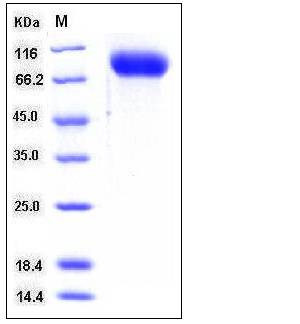Mouse ICAM-1 / CD54 Protein (His Tag)
CD54,Icam-1,Ly-47,MALA-2
- 100ug (NPP3355) Please inquiry
| Catalog Number | P50440-M08H |
|---|---|
| Organism Species | Mouse |
| Host | Human Cells |
| Synonyms | CD54,Icam-1,Ly-47,MALA-2 |
| Molecular Weight | The recombinant mouse ICAM1 consists of 469 amino acids after removal of the signal peptide. and has a predicted molecular mass of 51.7 kDa. In SDS-PAGE under reducing conditions, the apparent molecular mass of rm ICAM1 is approximately 80-90 kDa due to glycosylation. |
| predicted N | Gln 28 |
| SDS-PAGE |  |
| Purity | > 96 % as determined by SDS-PAGE |
| Protein Construction | A DNA sequence encoding the extracellular domain of mouse ICAM1 (NP_034623.1) (Met 1-Asn 485) was fused with a polyhistidine tag at the C-terminus. |
| Bio-activity | Measured by the ability of the immobilized protein to support the adhesion of PMA-stimulated HSB2 human peripheral blood acute lymphoblastic leukemia cells. When cells are added to mouse ICAM1 coated plates (12.5 μg/mL, 100 μL/well), approximately > 40% cells will adhere specifically. |
| Research Area | Microbiology |Pathogenic microorganism |viruses |animal virus |viral illness |Viral tract respiratory illness | |
| Formulation | Lyophilized from sterile PBS, pH 7.4 1. Normally 5 % - 8 % trehalose, mannitol and 0.01% Tween80 are added as protectants before lyophilization. Specific concentrations are included in the hardcopy of COA. |
| Background | Intercellular adhesion molecule-1 (ICAM-1, or CD54) is a 90 kDa member of the immunoglobulin (Ig) superfamily and is critical for the firm arrest and transmigration of leukocytes out of blood vessels and into tissues. ICAM-1 is constitutively present on endothelial cells, but its expression is increased by proinflammatory cytokines. The endothelial expression of ICAM-1 is increased in atherosclerotic and transplant-associated atherosclerotic tissue and in animal models of atherosclerosis. Additionally, ICAM-1 has been implicated in the progression of autoimmune diseases. ICAM-1 is a ligand for LFA-1(integrin). When activated, leukocytes bind to endothelial cells via ICAM-1/LFA-1 interaction and then transmigrate into tissues. Presence with heavy glycosylation and other structural characteristics, ICAM-1 possesses binding sites for a number of immune-associated ligands and serves as the binding site for entry of the major group of human Rhinovirus (HRV) into various cell types. ICAM-1 also becomes known for its affinity for Plasmodium falciparum-infected erythrocytes (PFIE), providing more of a role in infectious disease. Previous studies have shown that ICAM-1 is involved in inflammatory reactions and that a defect in ICAM-1 gene inhibits allergic contact hypersensitivity. |
| Reference |
